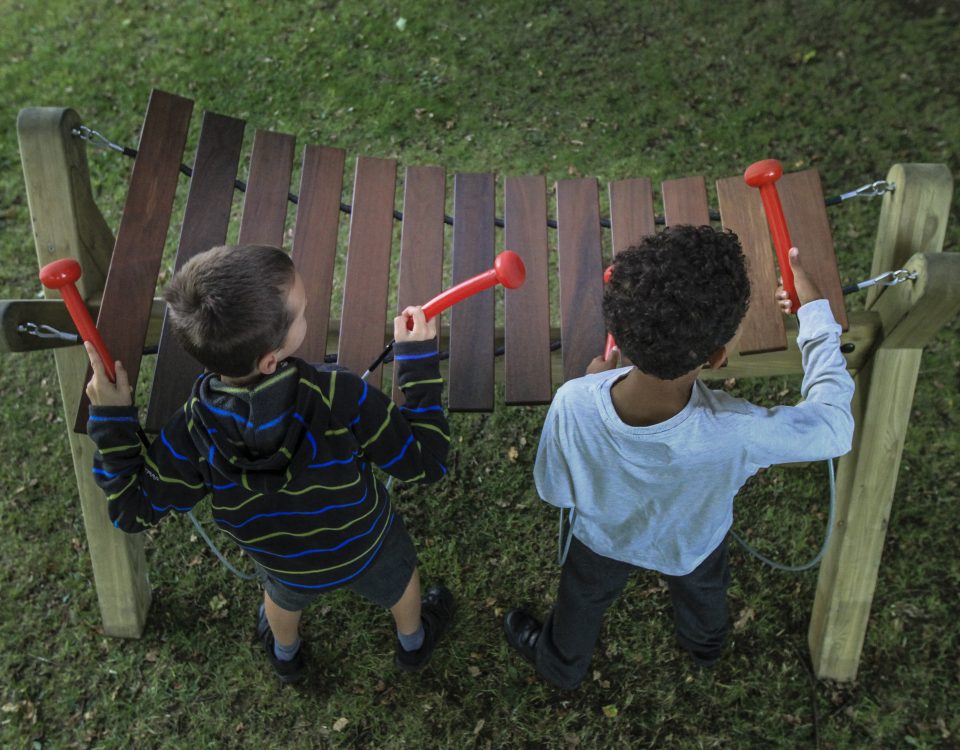Marimbas
These substantial Outdoor Marimbas are extremely popular and perfect as; school playground equipment, for use during music therapy sessions and creative playgrounds. Our Outdoor Marimbas allow musicians and non-musicians alike to perform creative music in interesting outdoor settings.
Marimbas fall into a broad range of instruments called ‘bar percussion instruments’ – instruments consisting of a large frame holding resonator bars made with both wooden or non-wooden notes. This musical instrument is played with mallets. The modern marimba is a mellower version of the xylophone. The term Marimba is used for wooden bar instruments with probable origins in eastern or southern Africa. The words rimba (= xylophone with a single bar) and ma (= a great number of objects) are Bantu (spoken in Malawi and Mozambique). In many African languages the term ma-rimba is therefore used to describe instruments with several bars.
Bar percussion instruments appear to be among the oldest of musical instruments with a long history in many diverse cultures over the world. The marimba's roots are ancient, extending to early human instincts to strike wood, stone and other objects that produced musical tones. The exact origin of the Marimba is not known, but it seems it started off as wooden bars laid over a hole on the ground which was struck with sticks. Most marimbas were made using local materials such as mazhara, mahogany or wood from the wild mango (Mutondo) tree in South Africa.
The marimba was probably taken to South America by African slaves and have been present in Central and parts of South America for several centuries, best known through the popular marimba music of Guatemala. Its catchy melodies, sentimental harmonies, and dance rhythms are the signature of Guatemala's national musical instrument and it has remained a popular folk instrument in Central America. Shortly after 1900, bar instruments for commercial sale began to be manufactured in the USA. John Calhoun Deagan, musician and manufacturer, developed the Marimba and many other musical instruments from crude beginnings into accepted musical instruments. He introduced a marimba tuned to a standard western scale with the keys arranged in the pattern of a piano keyboard.
Currently Marimba bars are typically made of either wood or a synthetic material. Percussion Play have Marimbas with both hardwood notes and glass-reinforced plastic (GRP) that will stand up to the rigors of being outdoors 24/7. Like the xylophone, the orchestral marimba is a set of wooden bars, often made of rosewood, mounted on a stand, with each bar having its own resonator. The upper limits of bar percussion are already well explored by the xylophone and glockenspiel and the Marimba is distinguished by its resonant, mellow tone, contrasting with the xylophone’s sharp, short sound. Marimba bars produce their fullest sound when struck just off centre.
Percussion Play’s Grand Marimba has notes made of IPE securely mounted onto individual resonator tubes on the underside. The resonator reflects and projects the sound back to the player, creates maximum vibration and increases the volume and resonance. Tubular resonators for bar instruments are tuned primarily by length: the longer the tube, the lower the resonance pitch. The bar set on the Percussion Play Akadinda and Marimba instruments are not set over resonators. Because it does not have resonating tubes, the dynamic range is lower and it’s primarily the length and shape of the bar and its vibrational modes which gives bar percussion its distinctive sound quality. The bars in this format will still highlight to the player how the speed and intensity of the strike of the mallet will affect the sound produced as will the type and size of mallet used.





